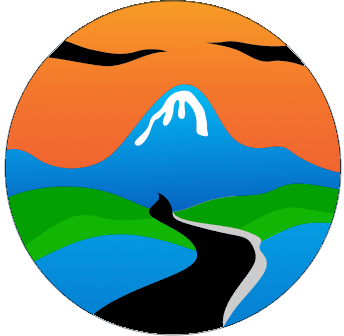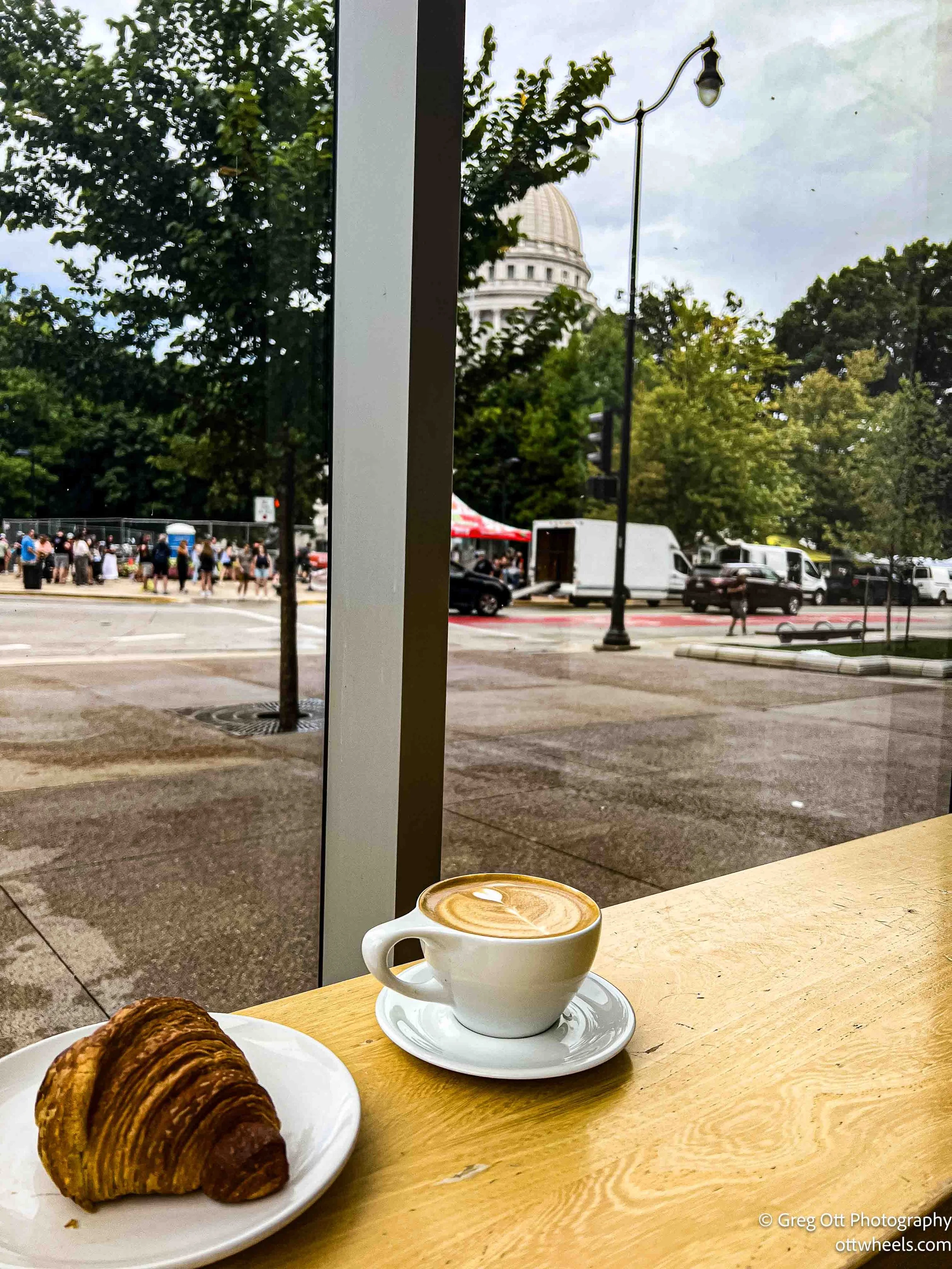Wisconsin State Capitol-Madison
I rolled into Madison planning to visit the Wisconsin State Capitol—and immediately hit a wall of traffic. Every parking spot from the outskirts to the square was packed. I didn’t know it at the time, but the Saturday farmers market was in full swing, and the city was buzzing with students. I figured school would’ve been out, but apparently not in a college town like this.
After 45 minutes of circling and grumbling, I gave up on finding a long-term spot and pulled into a street space about half a mile from the Capitol. No meters, just signs warning of a two-hour limit between 8 and 6. I figured unless someone’s out there chalking tires, I’d take my chances.
The walk uphill toward the Capitol wasn’t too steep. About two blocks away, I stopped two women—faces painted, probably fresh from some campus performance—and asked for a good nearby coffee shop with pastries. Not only did they give me three recommendations, but full-on pastry reviews, right down to flake levels and sourdough fermentation profiles (e.g. a lot of detail). They told me to enjoy Madison.
Wonderstate Coffee
I landed at Wonderstate Coffee a block away, where they had just sold out of chocolate croissants. Tragic. I settled for a butter croissant and a medium latte, ate quickly, and made the uphill push to the Capitol. I arrived three minutes late, but there was no line, no security check, and the information desk pointed me to the tour group, which was just gathering. About 15 people to start—closer to 30 by the end.
Wisconsin State Capitol
The Wisconsin State Capitol tour turned out to be a great way to spend an hour on a Saturday. We started in the ground floor rotunda, which is enormous—apparently it’s the largest granite dome in the U.S. The tour guide kicked things off with a bit of state history: Wisconsin became the 30th state in 1848, and this is actually the fourth capitol building. One burned to the ground in the early 1900s, and the current one, finished in 1917, was designed by architect George B. Post—same guy who did the New York Stock Exchange. That Beaux-Arts design is everywhere: grand staircases, ornate murals, tons of symmetry. And the stonework—43 types from 6 countries and 8 U.S. states—is a geology lover’s dream. Pink Tennessee marble, red granite from Waupaca, and limestone loaded with actual fossils? Come on.
Wisconsin, the name itself, comes from a Native word (likely Ojibwe or Miami) that roughly translates to “river running through red stone” or “water over red rock.” That red stone reference is more than just poetic—it’s rooted in the land’s geology and seems to have carried into the state’s cultural identity. You see the color red everywhere: the red granite used in buildings, the red hues of natural rock formations, and even the University of Wisconsin’s school colors—bright cardinal red and white. It’s hard not to think there’s a throughline here, from ancient red rock to modern symbolism. We also learned why Wisconsinites are called "badgers"—not for the animal, but because early lead miners dug into hillsides to live underground like badgers. That’s the kind of quirky historical detail I love. The guide also pointed out that this is one of the few state capitols that houses all three branches of government under one dome: legislative, executive, and judicial. You can walk from the governor’s conference room to the Supreme Court chamber in about 30 seconds.
Each of those branches has its own section of the building. The Assembly chamber (east wing) is big and brassy, with lots of wood and a giant mural over the Speaker’s desk. The Senate chamber (south wing) is a little smaller and more intimate, but just as elegant, with rich red marble and brass chandeliers. Then there’s the Supreme Court on the west wing—probably my favorite room. It’s decked out in Italian marble, and there’s a massive mural depicting Justice flanked by Socrates and historical lawgivers. The kicker? Wisconsin’s Supreme Court justices are elected for 10-year terms, and as of now, all but one are women. Kind of a cool fact.
We went up into the dome later in the tour, and the views were impressive. There’s a spot just below the dome where you can peer out over the rotunda from above, which gave me a real sense of the building’s scale. Then we climbed a little further to the sixth floor observation deck. That alone is worth the tour. It’s open air, wraps around the dome, and gives you panoramic views of Madison and both lakes. On a clear day, it’s kind of magical. Just inside that level are a few oddball historical artifacts, including a very cool 19th-century clock that runs on air pressure. It’s the kind of detail you might miss if you’re not looking for it—but it’s exactly the kind of thing that makes old buildings fascinating.
I spotted another replica of the Liberty Bell—one of 53 made in France in 1950 and gifted to each state and U.S. territory as part of a post-WWII savings bond campaign. They’re full-sized and made from the same mold as the original. This one sits quietly on the Capitol grounds, easy to miss if you’re not looking for it.
All in all, I’d say the Wisconsin State Capitol tour is well worth your time, especially if you like history, architecture, or just want a break from wandering the square. It’s free, informative, and full of those little stories that make a place feel alive. I left with a deeper appreciation for the state’s identity—and a phone full of dome pictures.
Outside of The Capitol Building
I walked the outside of the building and noted only one statue (Hans Christian Heg from Norway) on the grounds. There were several weddings in the building itself. I took several photos of wedding parties outside, and one of them would actually be getting married down the street later.
Babcock Hall Creamery
I toured the university of wisconsin campus in my vehicle and then stopped at the Babcock Hall creamery. I had to buy some cheese (cheddar). The cheese was actually very soft. It was aged cheese, so I expected it to be more firm. I also, had to have a couple scoops of Ice Cream, after all I was in the land of dairy.
While I was standing in line for ice cream, a little girl—maybe five—was chatting with her mom and dad. They’d asked her some thoughtful questions about traveling, and she answered like a tiny philosopher. I found myself thinking, these two must be professors or something, the way they were engaging with her. Then the girl paused, looked up, and said, “You know what I really want to do? I want to visit all the ice cream shops in the world.” I smiled—now that’s a worthy goal. Honestly, same. I love ice cream, and while I know I’ll never make it to every shop on Earth, part of me still wonders… how many are there?
Near the capital
I parked the van on one of the side streets near the capitol with a parking meter. It was close to 4 and at 6 parking was free. I took a short break in the van and read about a building Frank Lloyd Wright originally designed but wasn’t built during his lifetime. I had paid for two hours of parking and walked a few blocks to the Monona Terrace. As I walked, I stopped and took photos of buildings and read plaques.
One plaque, partly hidden behind a trash can, caught my eye. David James Schaefer (1955–2004) was a dedicated disability rights advocate for the city of Madison. Living with cerebral palsy, he worked to make public spaces more accessible and inclusive. His legacy lives on in the sidewalks and buildings he helped change. I couldn’t help but wonder—why place a trash can in front of his plaque?
Monona Terrace
I’d heard of the Monona Terrace before coming to Madison—just a passing mention in something I’d read—but didn’t know much beyond the name. When I learned it was originally designed by Frank Lloyd Wright, I had to know more. Why would one of America’s most famous architects design something that sat unbuilt for nearly 60 years?
I dug in. Wright first sketched the concept in 1938 as a civic center that would connect the Capitol to Lake Monona—a seamless blend of government, community, and nature. Madison even commissioned him to design it. But the project stalled. Funding dried up. Critics said it blocked the lake view. And some just didn’t like Wright’s vision. He revised the plans over and over, but died in 1959 without ever seeing it realized.
I walked the perimeter of the building, camera in hand, taking photos of bees drifting through the flowerbeds, the clean architectural lines, and the wide open view from the back deck. A couple I had seen earlier posing near the Capitol were actually getting married at 6 p.m. on the terrace. I ended up chatting with the DJ as he was setting up. He told me this was a part-time gig—he was studying psychology and heading to Marquette for his master’s in the fall. We talked for quite a while, just standing there in the hot sun with the lake behind us, until a security guard politely let me know the terrace was closing for the wedding and I’d have to move along.
It was only in the 1990s that Wright’s vision finally came to life. Interest in his work had grown, and former Mayor helped push the project through. One of Wright’s architect students, Tony Putnam, updated the design to meet modern codes, and in 1997—nearly six decades after Wright first imagined it—the Monona Terrace opened. It still feels like his work, just from a later era: long, smooth curves, post-war modern details, and an energy that flows as much as the lake it faces. I wondered how many building designs have been realized after the architect passes.
As I walked back to the van, I looked up and noticed a large, donut-shaped cloud hanging in the sky. I settled in the van, side door open, and spent some time processing photos and writing. The glow from inside must’ve been soft enough that people didn’t realize I was there—one by one, they stopped just feet from the door, having long, unfiltered conversations as if I were invisible.
I stopped at Walmart on the way to Cracker Barrel, but overnight parking was clearly banned—big signs at every entrance (very rare). A few miles down the road at Cracker Barrel, I pulled in next to a couple of other Class B vans already settled in for the night.


































